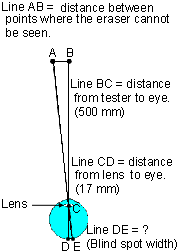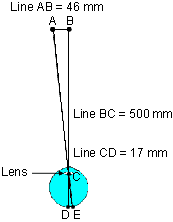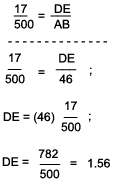| Measuring Your Blind Spot |
| The blind spot is caused when light falls on an area of
the retina without photoreceptors. How big is this area on the retina?
Here is one way to find out the horizontal diameter of the blind spot.
To calculate the width of your blind spot on your retina, let's assume that 1) the back of your eye is flat and 2) the distance from the lens of your eye to the retina is 17 mm. We will ignore the distance from the cornea to the lens. With the simple geometry of similar triangles, we can calculate the size of the blind spot because triangle ABC is similar to triangle CDE. So, the proportions of the lines will be similar. When I did this experiment, the measured distance between point A and point B was 46 mm. Inserting 46 mm into the equation, the blind spot on my retina has a diameter of 1.56 mm.
Further questions:
|
| GO TO: | Vision Experiments | Explore the Nervous System | Table of Contents |
![[email]](./gif/menue.gif) Send E-mail |
 Get Newsletter |
 Search Pages |


